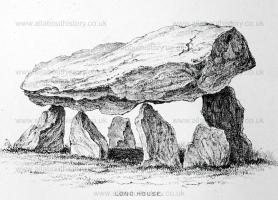Text this colour links to Pages. Text this colour links to Family Trees. Place the mouse over images to see a larger image. Click on paintings to see the painter's Biography Page. Mouse over links for a preview. Move the mouse off the painting or link to close the popup.
All About History Books
The Chronicle of Abbot Ralph of Coggeshall describes the reigns of Kings Henry II, Richard I, John and Henry III, providing a wealth of information about their lives and the events of the time. Ralph's work is detailed, comprehensive and objective. We have augmented Ralph's text with extracts from other contemporary chroniclers to enrich the reader's experience. Available at Amazon in eBook and Paperback.
Garnwnda Burial Chamber is in Llanwnda, Pembrokeshire, Prehistoric Wales Neolithic Burials.

Archaeologia Cambrensis 1872 Pages 81-143. Overlooking the little church of Llanwnda, near Fishguard, is what some, perhaps, would call a variety of the demi-dolmen [Garnwnda Burial Chamber [Map]]; but which is an ordinary dolmen, the capstone of which has slipped, and now rests in a standing position on only one of its supporters. It measures 14 ft. according to Fenton, and is somewhat of triangular form; not very dissimilar to the "Coetan Arthur [Map]" ~ cromlech near Criccieth (described in the Arch. Camb. of 1869, p. 135) in outline of form, but in its thickness very different from the rude masses such as those of Llech Tribedd and others. It is only 20 inches thick. The supporting stones are also of the same character. This dolmen is in such a dilapidated state that it does not contribute any light to the general subject, except as shewing how much the character of such structures depends on the kind of stone available. But for this fact one might be tempted, from its less massive character, to look upon it as somewhat later than the more massive and rougher monuments. On the lower ground are several upright stones irregularly placed; but it would be dangerous to speculate upon their character, as, with the exception of three or four, their age is very questionable.